Epidemiology Report: University Study on Clozapine and Weight Gain
VerifiedAdded on 2020/05/03
|12
|3618
|48
Report
AI Summary
This report analyzes a study investigating the effects of dietary control and exercise on schizophrenia patients undergoing clozapine treatment. The study involved 53 patients, divided into control and study groups, with the latter undergoing a six-month program of controlled calorie intake and physical activity. The findings revealed significant weight loss, reduced BMI, and improved metabolic parameters in the study group, suggesting the effectiveness of lifestyle interventions in mitigating the adverse effects of clozapine, such as weight gain and related health risks. The report discusses the plausibility of causal associations, external validity, and the overall quality of the study's discussion section, emphasizing the importance of monitoring and lifestyle adjustments for patients on clozapine to manage weight and improve health outcomes. The study highlights the need for long-term adherence to dietary control and regular exercise to prevent obesity-related complications and ensure sustained benefits for individuals with schizophrenia.
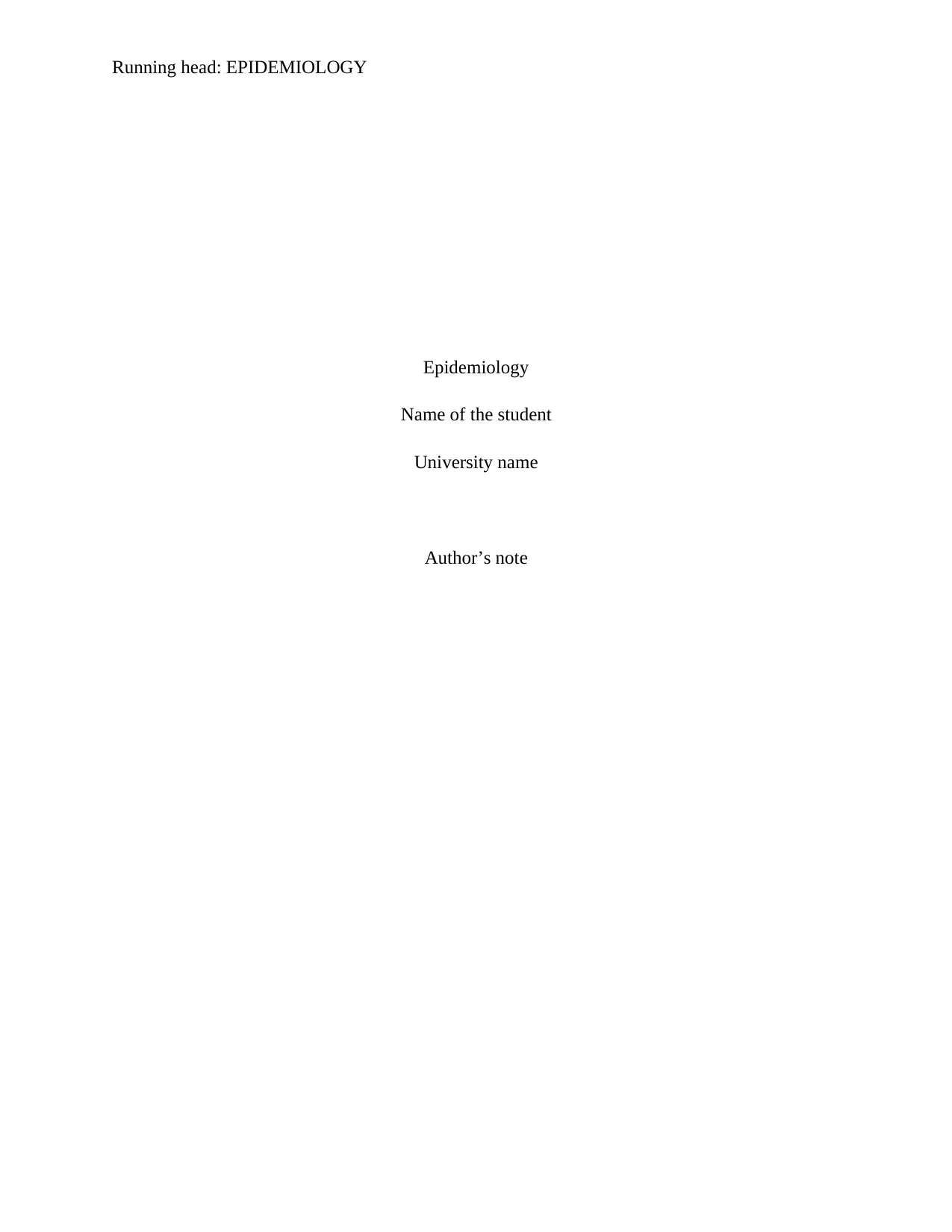
Running head: EPIDEMIOLOGY
Epidemiology
Name of the student
University name
Author’s note
Epidemiology
Name of the student
University name
Author’s note
Paraphrase This Document
Need a fresh take? Get an instant paraphrase of this document with our AI Paraphraser
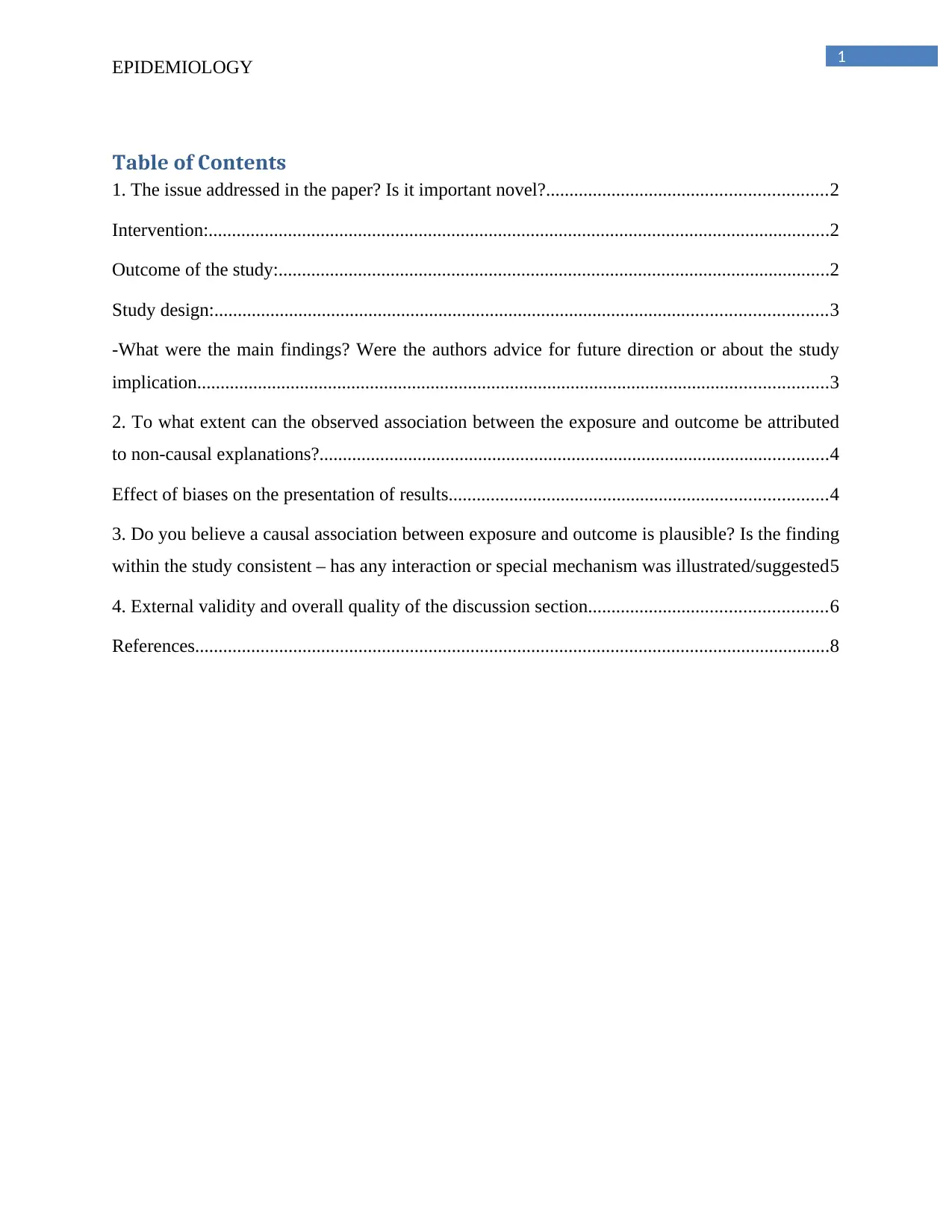
1
EPIDEMIOLOGY
Table of Contents
1. The issue addressed in the paper? Is it important novel?............................................................2
Intervention:.....................................................................................................................................2
Outcome of the study:......................................................................................................................2
Study design:...................................................................................................................................3
-What were the main findings? Were the authors advice for future direction or about the study
implication.......................................................................................................................................3
2. To what extent can the observed association between the exposure and outcome be attributed
to non-causal explanations?.............................................................................................................4
Effect of biases on the presentation of results.................................................................................4
3. Do you believe a causal association between exposure and outcome is plausible? Is the finding
within the study consistent – has any interaction or special mechanism was illustrated/suggested5
4. External validity and overall quality of the discussion section...................................................6
References........................................................................................................................................8
EPIDEMIOLOGY
Table of Contents
1. The issue addressed in the paper? Is it important novel?............................................................2
Intervention:.....................................................................................................................................2
Outcome of the study:......................................................................................................................2
Study design:...................................................................................................................................3
-What were the main findings? Were the authors advice for future direction or about the study
implication.......................................................................................................................................3
2. To what extent can the observed association between the exposure and outcome be attributed
to non-causal explanations?.............................................................................................................4
Effect of biases on the presentation of results.................................................................................4
3. Do you believe a causal association between exposure and outcome is plausible? Is the finding
within the study consistent – has any interaction or special mechanism was illustrated/suggested5
4. External validity and overall quality of the discussion section...................................................6
References........................................................................................................................................8
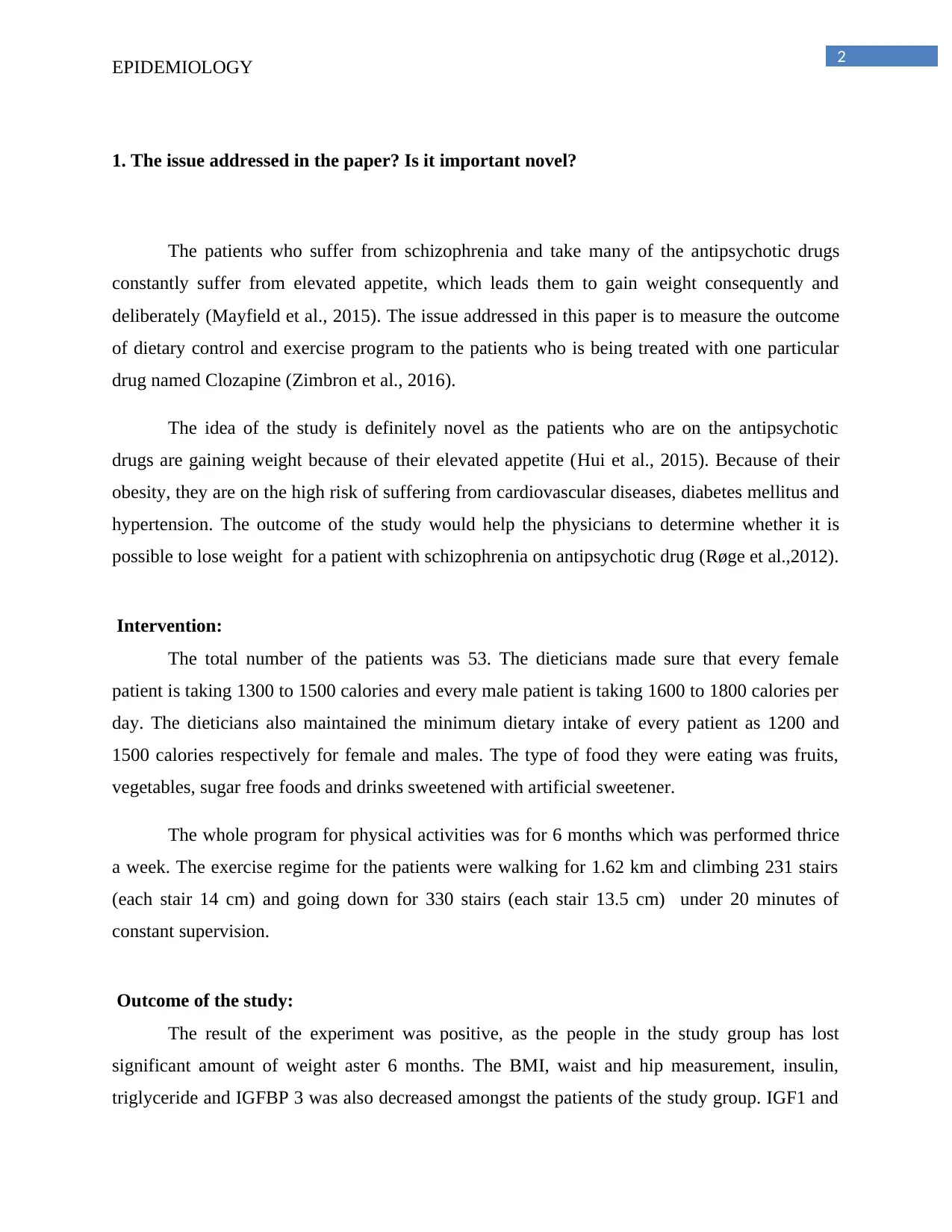
2
EPIDEMIOLOGY
1. The issue addressed in the paper? Is it important novel?
The patients who suffer from schizophrenia and take many of the antipsychotic drugs
constantly suffer from elevated appetite, which leads them to gain weight consequently and
deliberately (Mayfield et al., 2015). The issue addressed in this paper is to measure the outcome
of dietary control and exercise program to the patients who is being treated with one particular
drug named Clozapine (Zimbron et al., 2016).
The idea of the study is definitely novel as the patients who are on the antipsychotic
drugs are gaining weight because of their elevated appetite (Hui et al., 2015). Because of their
obesity, they are on the high risk of suffering from cardiovascular diseases, diabetes mellitus and
hypertension. The outcome of the study would help the physicians to determine whether it is
possible to lose weight for a patient with schizophrenia on antipsychotic drug (Røge et al.,2012).
Intervention:
The total number of the patients was 53. The dieticians made sure that every female
patient is taking 1300 to 1500 calories and every male patient is taking 1600 to 1800 calories per
day. The dieticians also maintained the minimum dietary intake of every patient as 1200 and
1500 calories respectively for female and males. The type of food they were eating was fruits,
vegetables, sugar free foods and drinks sweetened with artificial sweetener.
The whole program for physical activities was for 6 months which was performed thrice
a week. The exercise regime for the patients were walking for 1.62 km and climbing 231 stairs
(each stair 14 cm) and going down for 330 stairs (each stair 13.5 cm) under 20 minutes of
constant supervision.
Outcome of the study:
The result of the experiment was positive, as the people in the study group has lost
significant amount of weight aster 6 months. The BMI, waist and hip measurement, insulin,
triglyceride and IGFBP 3 was also decreased amongst the patients of the study group. IGF1 and
EPIDEMIOLOGY
1. The issue addressed in the paper? Is it important novel?
The patients who suffer from schizophrenia and take many of the antipsychotic drugs
constantly suffer from elevated appetite, which leads them to gain weight consequently and
deliberately (Mayfield et al., 2015). The issue addressed in this paper is to measure the outcome
of dietary control and exercise program to the patients who is being treated with one particular
drug named Clozapine (Zimbron et al., 2016).
The idea of the study is definitely novel as the patients who are on the antipsychotic
drugs are gaining weight because of their elevated appetite (Hui et al., 2015). Because of their
obesity, they are on the high risk of suffering from cardiovascular diseases, diabetes mellitus and
hypertension. The outcome of the study would help the physicians to determine whether it is
possible to lose weight for a patient with schizophrenia on antipsychotic drug (Røge et al.,2012).
Intervention:
The total number of the patients was 53. The dieticians made sure that every female
patient is taking 1300 to 1500 calories and every male patient is taking 1600 to 1800 calories per
day. The dieticians also maintained the minimum dietary intake of every patient as 1200 and
1500 calories respectively for female and males. The type of food they were eating was fruits,
vegetables, sugar free foods and drinks sweetened with artificial sweetener.
The whole program for physical activities was for 6 months which was performed thrice
a week. The exercise regime for the patients were walking for 1.62 km and climbing 231 stairs
(each stair 14 cm) and going down for 330 stairs (each stair 13.5 cm) under 20 minutes of
constant supervision.
Outcome of the study:
The result of the experiment was positive, as the people in the study group has lost
significant amount of weight aster 6 months. The BMI, waist and hip measurement, insulin,
triglyceride and IGFBP 3 was also decreased amongst the patients of the study group. IGF1 and
⊘ This is a preview!⊘
Do you want full access?
Subscribe today to unlock all pages.

Trusted by 1+ million students worldwide
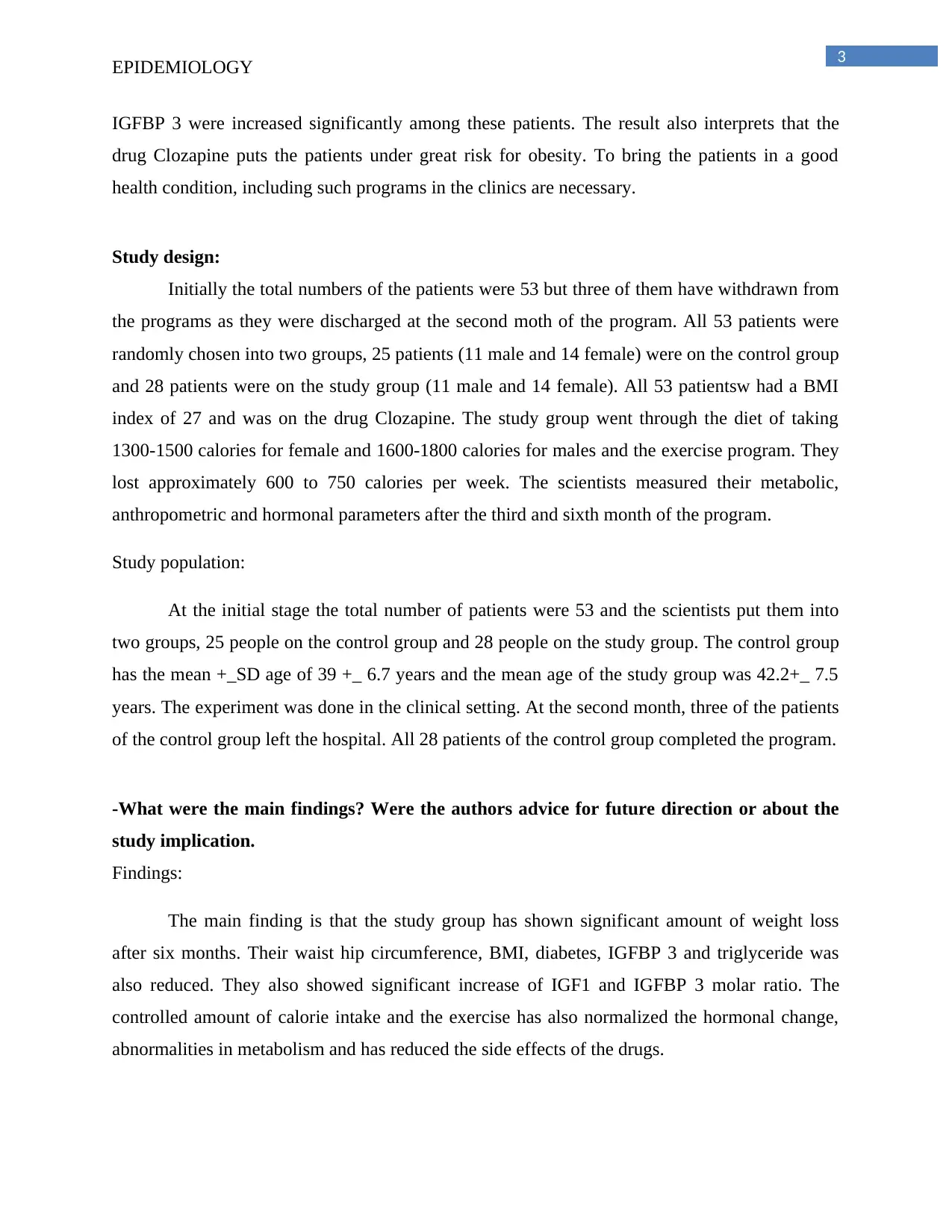
3
EPIDEMIOLOGY
IGFBP 3 were increased significantly among these patients. The result also interprets that the
drug Clozapine puts the patients under great risk for obesity. To bring the patients in a good
health condition, including such programs in the clinics are necessary.
Study design:
Initially the total numbers of the patients were 53 but three of them have withdrawn from
the programs as they were discharged at the second moth of the program. All 53 patients were
randomly chosen into two groups, 25 patients (11 male and 14 female) were on the control group
and 28 patients were on the study group (11 male and 14 female). All 53 patientsw had a BMI
index of 27 and was on the drug Clozapine. The study group went through the diet of taking
1300-1500 calories for female and 1600-1800 calories for males and the exercise program. They
lost approximately 600 to 750 calories per week. The scientists measured their metabolic,
anthropometric and hormonal parameters after the third and sixth month of the program.
Study population:
At the initial stage the total number of patients were 53 and the scientists put them into
two groups, 25 people on the control group and 28 people on the study group. The control group
has the mean +_SD age of 39 +_ 6.7 years and the mean age of the study group was 42.2+_ 7.5
years. The experiment was done in the clinical setting. At the second month, three of the patients
of the control group left the hospital. All 28 patients of the control group completed the program.
-What were the main findings? Were the authors advice for future direction or about the
study implication.
Findings:
The main finding is that the study group has shown significant amount of weight loss
after six months. Their waist hip circumference, BMI, diabetes, IGFBP 3 and triglyceride was
also reduced. They also showed significant increase of IGF1 and IGFBP 3 molar ratio. The
controlled amount of calorie intake and the exercise has also normalized the hormonal change,
abnormalities in metabolism and has reduced the side effects of the drugs.
EPIDEMIOLOGY
IGFBP 3 were increased significantly among these patients. The result also interprets that the
drug Clozapine puts the patients under great risk for obesity. To bring the patients in a good
health condition, including such programs in the clinics are necessary.
Study design:
Initially the total numbers of the patients were 53 but three of them have withdrawn from
the programs as they were discharged at the second moth of the program. All 53 patients were
randomly chosen into two groups, 25 patients (11 male and 14 female) were on the control group
and 28 patients were on the study group (11 male and 14 female). All 53 patientsw had a BMI
index of 27 and was on the drug Clozapine. The study group went through the diet of taking
1300-1500 calories for female and 1600-1800 calories for males and the exercise program. They
lost approximately 600 to 750 calories per week. The scientists measured their metabolic,
anthropometric and hormonal parameters after the third and sixth month of the program.
Study population:
At the initial stage the total number of patients were 53 and the scientists put them into
two groups, 25 people on the control group and 28 people on the study group. The control group
has the mean +_SD age of 39 +_ 6.7 years and the mean age of the study group was 42.2+_ 7.5
years. The experiment was done in the clinical setting. At the second month, three of the patients
of the control group left the hospital. All 28 patients of the control group completed the program.
-What were the main findings? Were the authors advice for future direction or about the
study implication.
Findings:
The main finding is that the study group has shown significant amount of weight loss
after six months. Their waist hip circumference, BMI, diabetes, IGFBP 3 and triglyceride was
also reduced. They also showed significant increase of IGF1 and IGFBP 3 molar ratio. The
controlled amount of calorie intake and the exercise has also normalized the hormonal change,
abnormalities in metabolism and has reduced the side effects of the drugs.
Paraphrase This Document
Need a fresh take? Get an instant paraphrase of this document with our AI Paraphraser
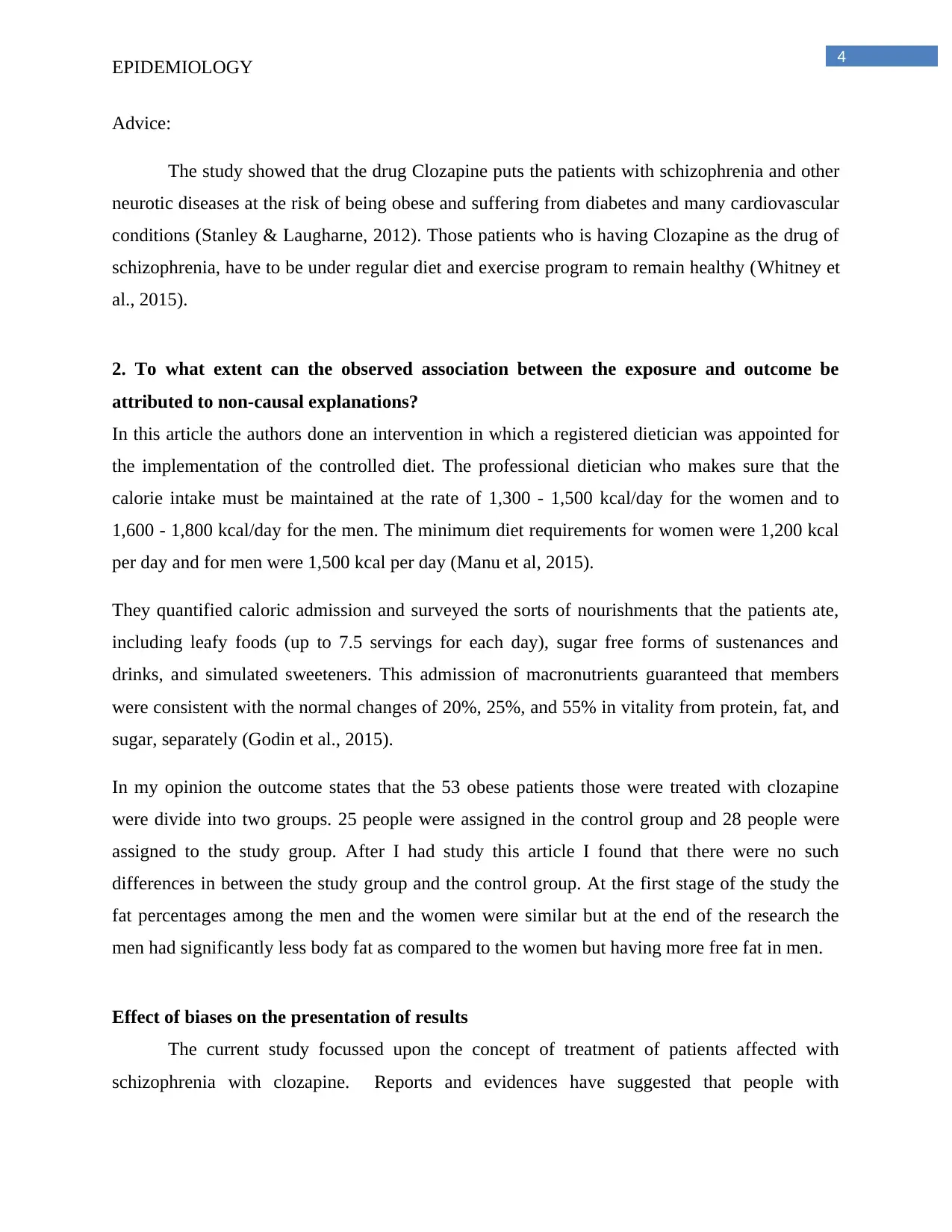
4
EPIDEMIOLOGY
Advice:
The study showed that the drug Clozapine puts the patients with schizophrenia and other
neurotic diseases at the risk of being obese and suffering from diabetes and many cardiovascular
conditions (Stanley & Laugharne, 2012). Those patients who is having Clozapine as the drug of
schizophrenia, have to be under regular diet and exercise program to remain healthy (Whitney et
al., 2015).
2. To what extent can the observed association between the exposure and outcome be
attributed to non-causal explanations?
In this article the authors done an intervention in which a registered dietician was appointed for
the implementation of the controlled diet. The professional dietician who makes sure that the
calorie intake must be maintained at the rate of 1,300 - 1,500 kcal/day for the women and to
1,600 - 1,800 kcal/day for the men. The minimum diet requirements for women were 1,200 kcal
per day and for men were 1,500 kcal per day (Manu et al, 2015).
They quantified caloric admission and surveyed the sorts of nourishments that the patients ate,
including leafy foods (up to 7.5 servings for each day), sugar free forms of sustenances and
drinks, and simulated sweeteners. This admission of macronutrients guaranteed that members
were consistent with the normal changes of 20%, 25%, and 55% in vitality from protein, fat, and
sugar, separately (Godin et al., 2015).
In my opinion the outcome states that the 53 obese patients those were treated with clozapine
were divide into two groups. 25 people were assigned in the control group and 28 people were
assigned to the study group. After I had study this article I found that there were no such
differences in between the study group and the control group. At the first stage of the study the
fat percentages among the men and the women were similar but at the end of the research the
men had significantly less body fat as compared to the women but having more free fat in men.
Effect of biases on the presentation of results
The current study focussed upon the concept of treatment of patients affected with
schizophrenia with clozapine. Reports and evidences have suggested that people with
EPIDEMIOLOGY
Advice:
The study showed that the drug Clozapine puts the patients with schizophrenia and other
neurotic diseases at the risk of being obese and suffering from diabetes and many cardiovascular
conditions (Stanley & Laugharne, 2012). Those patients who is having Clozapine as the drug of
schizophrenia, have to be under regular diet and exercise program to remain healthy (Whitney et
al., 2015).
2. To what extent can the observed association between the exposure and outcome be
attributed to non-causal explanations?
In this article the authors done an intervention in which a registered dietician was appointed for
the implementation of the controlled diet. The professional dietician who makes sure that the
calorie intake must be maintained at the rate of 1,300 - 1,500 kcal/day for the women and to
1,600 - 1,800 kcal/day for the men. The minimum diet requirements for women were 1,200 kcal
per day and for men were 1,500 kcal per day (Manu et al, 2015).
They quantified caloric admission and surveyed the sorts of nourishments that the patients ate,
including leafy foods (up to 7.5 servings for each day), sugar free forms of sustenances and
drinks, and simulated sweeteners. This admission of macronutrients guaranteed that members
were consistent with the normal changes of 20%, 25%, and 55% in vitality from protein, fat, and
sugar, separately (Godin et al., 2015).
In my opinion the outcome states that the 53 obese patients those were treated with clozapine
were divide into two groups. 25 people were assigned in the control group and 28 people were
assigned to the study group. After I had study this article I found that there were no such
differences in between the study group and the control group. At the first stage of the study the
fat percentages among the men and the women were similar but at the end of the research the
men had significantly less body fat as compared to the women but having more free fat in men.
Effect of biases on the presentation of results
The current study focussed upon the concept of treatment of patients affected with
schizophrenia with clozapine. Reports and evidences have suggested that people with
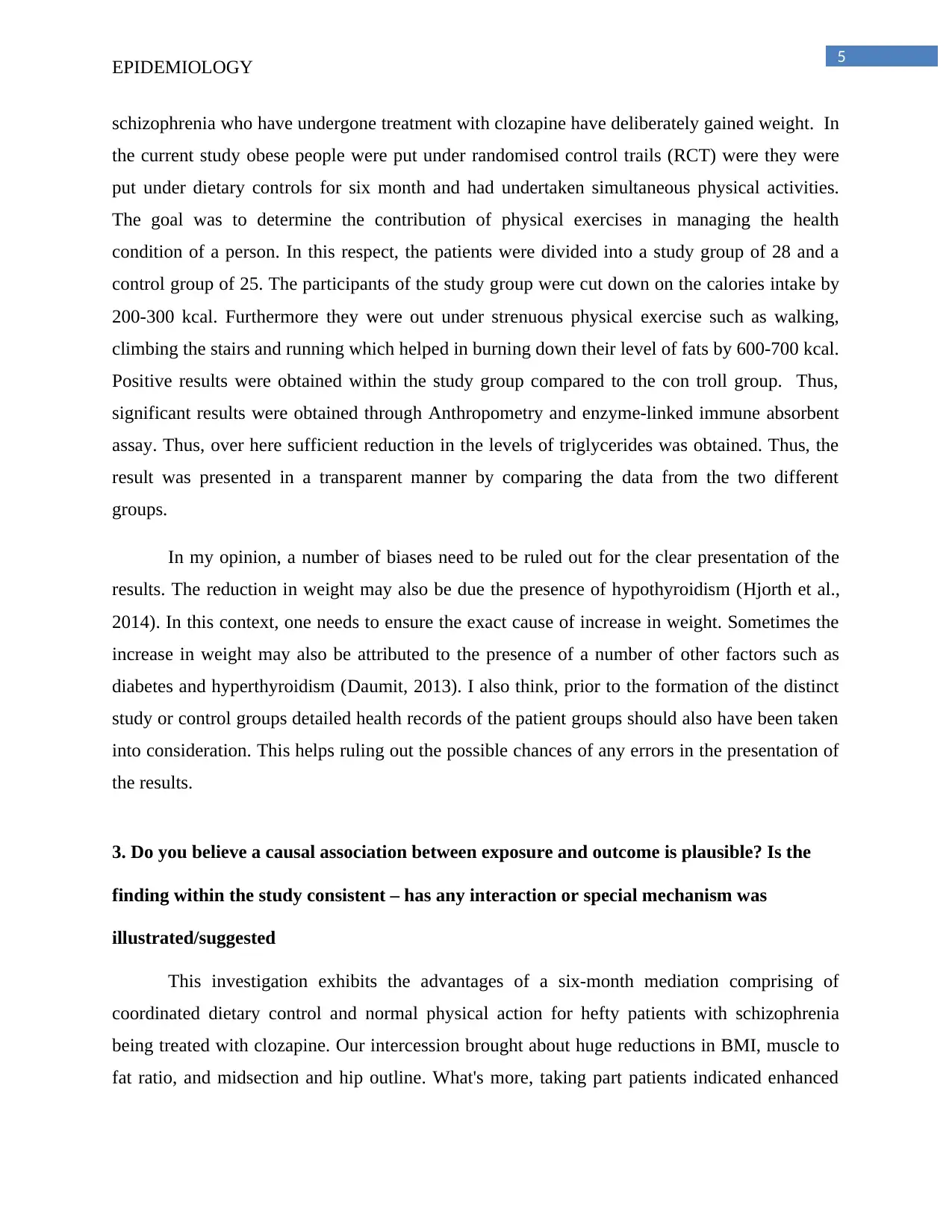
5
EPIDEMIOLOGY
schizophrenia who have undergone treatment with clozapine have deliberately gained weight. In
the current study obese people were put under randomised control trails (RCT) were they were
put under dietary controls for six month and had undertaken simultaneous physical activities.
The goal was to determine the contribution of physical exercises in managing the health
condition of a person. In this respect, the patients were divided into a study group of 28 and a
control group of 25. The participants of the study group were cut down on the calories intake by
200-300 kcal. Furthermore they were out under strenuous physical exercise such as walking,
climbing the stairs and running which helped in burning down their level of fats by 600-700 kcal.
Positive results were obtained within the study group compared to the con troll group. Thus,
significant results were obtained through Anthropometry and enzyme-linked immune absorbent
assay. Thus, over here sufficient reduction in the levels of triglycerides was obtained. Thus, the
result was presented in a transparent manner by comparing the data from the two different
groups.
In my opinion, a number of biases need to be ruled out for the clear presentation of the
results. The reduction in weight may also be due the presence of hypothyroidism (Hjorth et al.,
2014). In this context, one needs to ensure the exact cause of increase in weight. Sometimes the
increase in weight may also be attributed to the presence of a number of other factors such as
diabetes and hyperthyroidism (Daumit, 2013). I also think, prior to the formation of the distinct
study or control groups detailed health records of the patient groups should also have been taken
into consideration. This helps ruling out the possible chances of any errors in the presentation of
the results.
3. Do you believe a causal association between exposure and outcome is plausible? Is the
finding within the study consistent – has any interaction or special mechanism was
illustrated/suggested
This investigation exhibits the advantages of a six-month mediation comprising of
coordinated dietary control and normal physical action for hefty patients with schizophrenia
being treated with clozapine. Our intercession brought about huge reductions in BMI, muscle to
fat ratio, and midsection and hip outline. What's more, taking part patients indicated enhanced
EPIDEMIOLOGY
schizophrenia who have undergone treatment with clozapine have deliberately gained weight. In
the current study obese people were put under randomised control trails (RCT) were they were
put under dietary controls for six month and had undertaken simultaneous physical activities.
The goal was to determine the contribution of physical exercises in managing the health
condition of a person. In this respect, the patients were divided into a study group of 28 and a
control group of 25. The participants of the study group were cut down on the calories intake by
200-300 kcal. Furthermore they were out under strenuous physical exercise such as walking,
climbing the stairs and running which helped in burning down their level of fats by 600-700 kcal.
Positive results were obtained within the study group compared to the con troll group. Thus,
significant results were obtained through Anthropometry and enzyme-linked immune absorbent
assay. Thus, over here sufficient reduction in the levels of triglycerides was obtained. Thus, the
result was presented in a transparent manner by comparing the data from the two different
groups.
In my opinion, a number of biases need to be ruled out for the clear presentation of the
results. The reduction in weight may also be due the presence of hypothyroidism (Hjorth et al.,
2014). In this context, one needs to ensure the exact cause of increase in weight. Sometimes the
increase in weight may also be attributed to the presence of a number of other factors such as
diabetes and hyperthyroidism (Daumit, 2013). I also think, prior to the formation of the distinct
study or control groups detailed health records of the patient groups should also have been taken
into consideration. This helps ruling out the possible chances of any errors in the presentation of
the results.
3. Do you believe a causal association between exposure and outcome is plausible? Is the
finding within the study consistent – has any interaction or special mechanism was
illustrated/suggested
This investigation exhibits the advantages of a six-month mediation comprising of
coordinated dietary control and normal physical action for hefty patients with schizophrenia
being treated with clozapine. Our intercession brought about huge reductions in BMI, muscle to
fat ratio, and midsection and hip outline. What's more, taking part patients indicated enhanced
⊘ This is a preview!⊘
Do you want full access?
Subscribe today to unlock all pages.

Trusted by 1+ million students worldwide
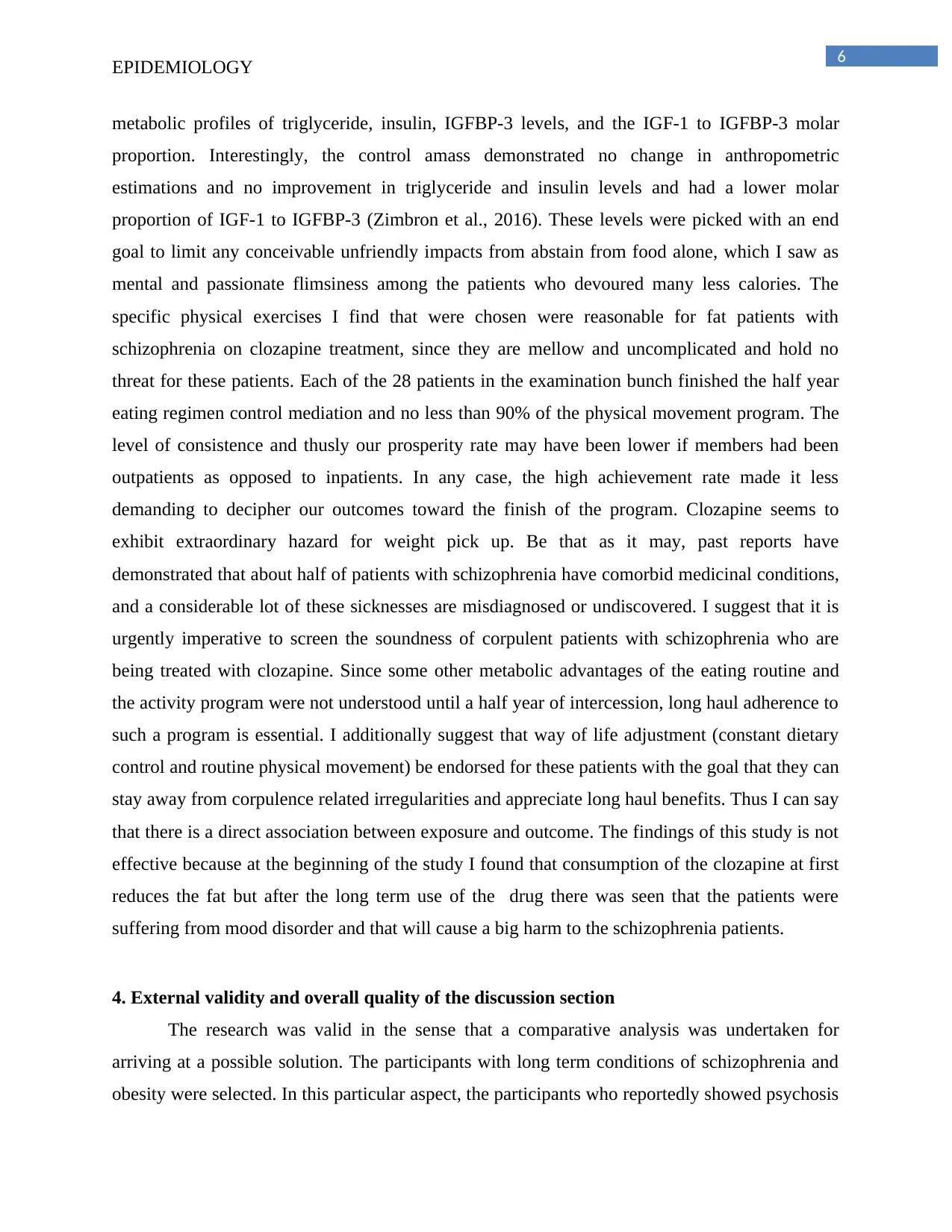
6
EPIDEMIOLOGY
metabolic profiles of triglyceride, insulin, IGFBP-3 levels, and the IGF-1 to IGFBP-3 molar
proportion. Interestingly, the control amass demonstrated no change in anthropometric
estimations and no improvement in triglyceride and insulin levels and had a lower molar
proportion of IGF-1 to IGFBP-3 (Zimbron et al., 2016). These levels were picked with an end
goal to limit any conceivable unfriendly impacts from abstain from food alone, which I saw as
mental and passionate flimsiness among the patients who devoured many less calories. The
specific physical exercises I find that were chosen were reasonable for fat patients with
schizophrenia on clozapine treatment, since they are mellow and uncomplicated and hold no
threat for these patients. Each of the 28 patients in the examination bunch finished the half year
eating regimen control mediation and no less than 90% of the physical movement program. The
level of consistence and thusly our prosperity rate may have been lower if members had been
outpatients as opposed to inpatients. In any case, the high achievement rate made it less
demanding to decipher our outcomes toward the finish of the program. Clozapine seems to
exhibit extraordinary hazard for weight pick up. Be that as it may, past reports have
demonstrated that about half of patients with schizophrenia have comorbid medicinal conditions,
and a considerable lot of these sicknesses are misdiagnosed or undiscovered. I suggest that it is
urgently imperative to screen the soundness of corpulent patients with schizophrenia who are
being treated with clozapine. Since some other metabolic advantages of the eating routine and
the activity program were not understood until a half year of intercession, long haul adherence to
such a program is essential. I additionally suggest that way of life adjustment (constant dietary
control and routine physical movement) be endorsed for these patients with the goal that they can
stay away from corpulence related irregularities and appreciate long haul benefits. Thus I can say
that there is a direct association between exposure and outcome. The findings of this study is not
effective because at the beginning of the study I found that consumption of the clozapine at first
reduces the fat but after the long term use of the drug there was seen that the patients were
suffering from mood disorder and that will cause a big harm to the schizophrenia patients.
4. External validity and overall quality of the discussion section
The research was valid in the sense that a comparative analysis was undertaken for
arriving at a possible solution. The participants with long term conditions of schizophrenia and
obesity were selected. In this particular aspect, the participants who reportedly showed psychosis
EPIDEMIOLOGY
metabolic profiles of triglyceride, insulin, IGFBP-3 levels, and the IGF-1 to IGFBP-3 molar
proportion. Interestingly, the control amass demonstrated no change in anthropometric
estimations and no improvement in triglyceride and insulin levels and had a lower molar
proportion of IGF-1 to IGFBP-3 (Zimbron et al., 2016). These levels were picked with an end
goal to limit any conceivable unfriendly impacts from abstain from food alone, which I saw as
mental and passionate flimsiness among the patients who devoured many less calories. The
specific physical exercises I find that were chosen were reasonable for fat patients with
schizophrenia on clozapine treatment, since they are mellow and uncomplicated and hold no
threat for these patients. Each of the 28 patients in the examination bunch finished the half year
eating regimen control mediation and no less than 90% of the physical movement program. The
level of consistence and thusly our prosperity rate may have been lower if members had been
outpatients as opposed to inpatients. In any case, the high achievement rate made it less
demanding to decipher our outcomes toward the finish of the program. Clozapine seems to
exhibit extraordinary hazard for weight pick up. Be that as it may, past reports have
demonstrated that about half of patients with schizophrenia have comorbid medicinal conditions,
and a considerable lot of these sicknesses are misdiagnosed or undiscovered. I suggest that it is
urgently imperative to screen the soundness of corpulent patients with schizophrenia who are
being treated with clozapine. Since some other metabolic advantages of the eating routine and
the activity program were not understood until a half year of intercession, long haul adherence to
such a program is essential. I additionally suggest that way of life adjustment (constant dietary
control and routine physical movement) be endorsed for these patients with the goal that they can
stay away from corpulence related irregularities and appreciate long haul benefits. Thus I can say
that there is a direct association between exposure and outcome. The findings of this study is not
effective because at the beginning of the study I found that consumption of the clozapine at first
reduces the fat but after the long term use of the drug there was seen that the patients were
suffering from mood disorder and that will cause a big harm to the schizophrenia patients.
4. External validity and overall quality of the discussion section
The research was valid in the sense that a comparative analysis was undertaken for
arriving at a possible solution. The participants with long term conditions of schizophrenia and
obesity were selected. In this particular aspect, the participants who reportedly showed psychosis
Paraphrase This Document
Need a fresh take? Get an instant paraphrase of this document with our AI Paraphraser
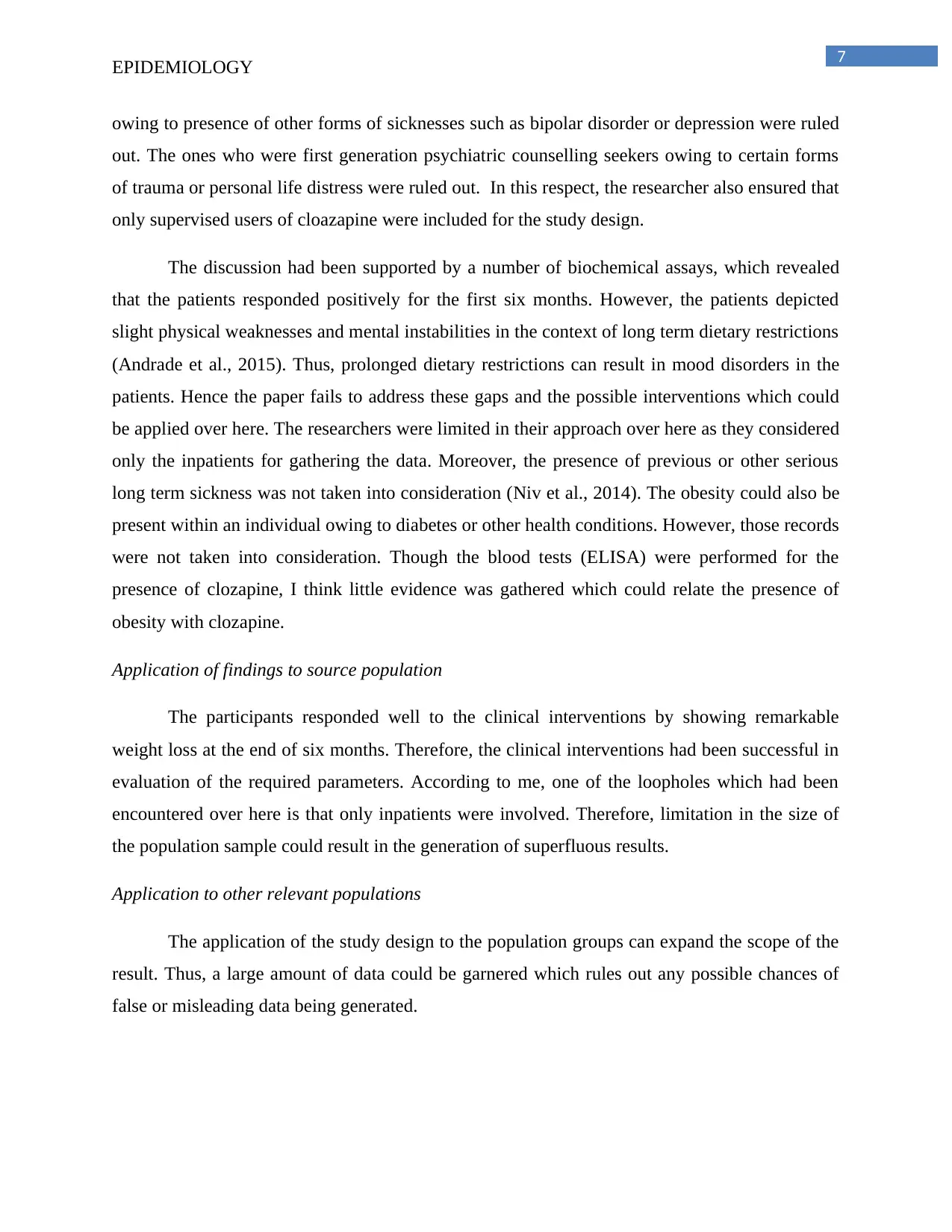
7
EPIDEMIOLOGY
owing to presence of other forms of sicknesses such as bipolar disorder or depression were ruled
out. The ones who were first generation psychiatric counselling seekers owing to certain forms
of trauma or personal life distress were ruled out. In this respect, the researcher also ensured that
only supervised users of cloazapine were included for the study design.
The discussion had been supported by a number of biochemical assays, which revealed
that the patients responded positively for the first six months. However, the patients depicted
slight physical weaknesses and mental instabilities in the context of long term dietary restrictions
(Andrade et al., 2015). Thus, prolonged dietary restrictions can result in mood disorders in the
patients. Hence the paper fails to address these gaps and the possible interventions which could
be applied over here. The researchers were limited in their approach over here as they considered
only the inpatients for gathering the data. Moreover, the presence of previous or other serious
long term sickness was not taken into consideration (Niv et al., 2014). The obesity could also be
present within an individual owing to diabetes or other health conditions. However, those records
were not taken into consideration. Though the blood tests (ELISA) were performed for the
presence of clozapine, I think little evidence was gathered which could relate the presence of
obesity with clozapine.
Application of findings to source population
The participants responded well to the clinical interventions by showing remarkable
weight loss at the end of six months. Therefore, the clinical interventions had been successful in
evaluation of the required parameters. According to me, one of the loopholes which had been
encountered over here is that only inpatients were involved. Therefore, limitation in the size of
the population sample could result in the generation of superfluous results.
Application to other relevant populations
The application of the study design to the population groups can expand the scope of the
result. Thus, a large amount of data could be garnered which rules out any possible chances of
false or misleading data being generated.
EPIDEMIOLOGY
owing to presence of other forms of sicknesses such as bipolar disorder or depression were ruled
out. The ones who were first generation psychiatric counselling seekers owing to certain forms
of trauma or personal life distress were ruled out. In this respect, the researcher also ensured that
only supervised users of cloazapine were included for the study design.
The discussion had been supported by a number of biochemical assays, which revealed
that the patients responded positively for the first six months. However, the patients depicted
slight physical weaknesses and mental instabilities in the context of long term dietary restrictions
(Andrade et al., 2015). Thus, prolonged dietary restrictions can result in mood disorders in the
patients. Hence the paper fails to address these gaps and the possible interventions which could
be applied over here. The researchers were limited in their approach over here as they considered
only the inpatients for gathering the data. Moreover, the presence of previous or other serious
long term sickness was not taken into consideration (Niv et al., 2014). The obesity could also be
present within an individual owing to diabetes or other health conditions. However, those records
were not taken into consideration. Though the blood tests (ELISA) were performed for the
presence of clozapine, I think little evidence was gathered which could relate the presence of
obesity with clozapine.
Application of findings to source population
The participants responded well to the clinical interventions by showing remarkable
weight loss at the end of six months. Therefore, the clinical interventions had been successful in
evaluation of the required parameters. According to me, one of the loopholes which had been
encountered over here is that only inpatients were involved. Therefore, limitation in the size of
the population sample could result in the generation of superfluous results.
Application to other relevant populations
The application of the study design to the population groups can expand the scope of the
result. Thus, a large amount of data could be garnered which rules out any possible chances of
false or misleading data being generated.
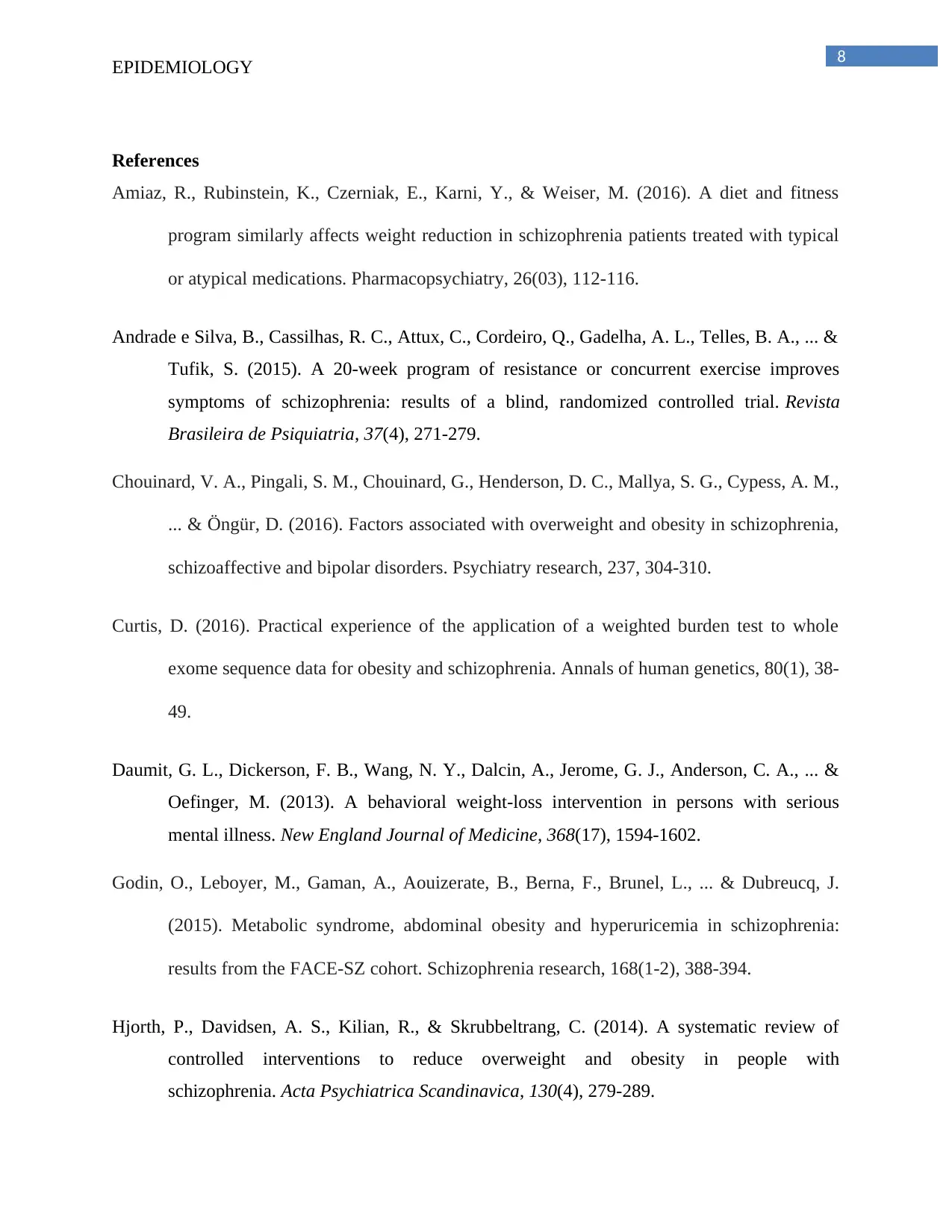
8
EPIDEMIOLOGY
References
Amiaz, R., Rubinstein, K., Czerniak, E., Karni, Y., & Weiser, M. (2016). A diet and fitness
program similarly affects weight reduction in schizophrenia patients treated with typical
or atypical medications. Pharmacopsychiatry, 26(03), 112-116.
Andrade e Silva, B., Cassilhas, R. C., Attux, C., Cordeiro, Q., Gadelha, A. L., Telles, B. A., ... &
Tufik, S. (2015). A 20-week program of resistance or concurrent exercise improves
symptoms of schizophrenia: results of a blind, randomized controlled trial. Revista
Brasileira de Psiquiatria, 37(4), 271-279.
Chouinard, V. A., Pingali, S. M., Chouinard, G., Henderson, D. C., Mallya, S. G., Cypess, A. M.,
... & Öngür, D. (2016). Factors associated with overweight and obesity in schizophrenia,
schizoaffective and bipolar disorders. Psychiatry research, 237, 304-310.
Curtis, D. (2016). Practical experience of the application of a weighted burden test to whole
exome sequence data for obesity and schizophrenia. Annals of human genetics, 80(1), 38-
49.
Daumit, G. L., Dickerson, F. B., Wang, N. Y., Dalcin, A., Jerome, G. J., Anderson, C. A., ... &
Oefinger, M. (2013). A behavioral weight-loss intervention in persons with serious
mental illness. New England Journal of Medicine, 368(17), 1594-1602.
Godin, O., Leboyer, M., Gaman, A., Aouizerate, B., Berna, F., Brunel, L., ... & Dubreucq, J.
(2015). Metabolic syndrome, abdominal obesity and hyperuricemia in schizophrenia:
results from the FACE-SZ cohort. Schizophrenia research, 168(1-2), 388-394.
Hjorth, P., Davidsen, A. S., Kilian, R., & Skrubbeltrang, C. (2014). A systematic review of
controlled interventions to reduce overweight and obesity in people with
schizophrenia. Acta Psychiatrica Scandinavica, 130(4), 279-289.
EPIDEMIOLOGY
References
Amiaz, R., Rubinstein, K., Czerniak, E., Karni, Y., & Weiser, M. (2016). A diet and fitness
program similarly affects weight reduction in schizophrenia patients treated with typical
or atypical medications. Pharmacopsychiatry, 26(03), 112-116.
Andrade e Silva, B., Cassilhas, R. C., Attux, C., Cordeiro, Q., Gadelha, A. L., Telles, B. A., ... &
Tufik, S. (2015). A 20-week program of resistance or concurrent exercise improves
symptoms of schizophrenia: results of a blind, randomized controlled trial. Revista
Brasileira de Psiquiatria, 37(4), 271-279.
Chouinard, V. A., Pingali, S. M., Chouinard, G., Henderson, D. C., Mallya, S. G., Cypess, A. M.,
... & Öngür, D. (2016). Factors associated with overweight and obesity in schizophrenia,
schizoaffective and bipolar disorders. Psychiatry research, 237, 304-310.
Curtis, D. (2016). Practical experience of the application of a weighted burden test to whole
exome sequence data for obesity and schizophrenia. Annals of human genetics, 80(1), 38-
49.
Daumit, G. L., Dickerson, F. B., Wang, N. Y., Dalcin, A., Jerome, G. J., Anderson, C. A., ... &
Oefinger, M. (2013). A behavioral weight-loss intervention in persons with serious
mental illness. New England Journal of Medicine, 368(17), 1594-1602.
Godin, O., Leboyer, M., Gaman, A., Aouizerate, B., Berna, F., Brunel, L., ... & Dubreucq, J.
(2015). Metabolic syndrome, abdominal obesity and hyperuricemia in schizophrenia:
results from the FACE-SZ cohort. Schizophrenia research, 168(1-2), 388-394.
Hjorth, P., Davidsen, A. S., Kilian, R., & Skrubbeltrang, C. (2014). A systematic review of
controlled interventions to reduce overweight and obesity in people with
schizophrenia. Acta Psychiatrica Scandinavica, 130(4), 279-289.
⊘ This is a preview!⊘
Do you want full access?
Subscribe today to unlock all pages.

Trusted by 1+ million students worldwide
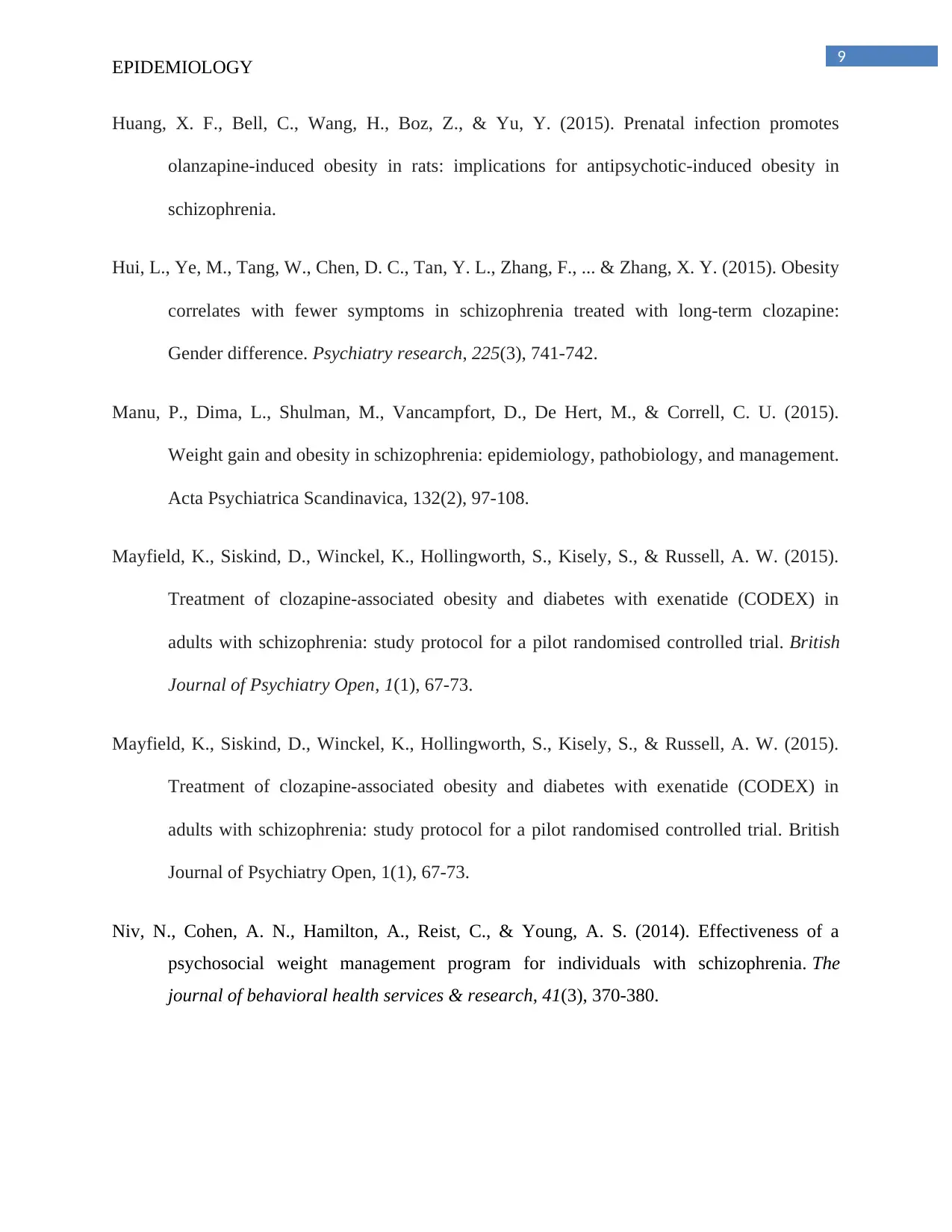
9
EPIDEMIOLOGY
Huang, X. F., Bell, C., Wang, H., Boz, Z., & Yu, Y. (2015). Prenatal infection promotes
olanzapine-induced obesity in rats: implications for antipsychotic-induced obesity in
schizophrenia.
Hui, L., Ye, M., Tang, W., Chen, D. C., Tan, Y. L., Zhang, F., ... & Zhang, X. Y. (2015). Obesity
correlates with fewer symptoms in schizophrenia treated with long-term clozapine:
Gender difference. Psychiatry research, 225(3), 741-742.
Manu, P., Dima, L., Shulman, M., Vancampfort, D., De Hert, M., & Correll, C. U. (2015).
Weight gain and obesity in schizophrenia: epidemiology, pathobiology, and management.
Acta Psychiatrica Scandinavica, 132(2), 97-108.
Mayfield, K., Siskind, D., Winckel, K., Hollingworth, S., Kisely, S., & Russell, A. W. (2015).
Treatment of clozapine-associated obesity and diabetes with exenatide (CODEX) in
adults with schizophrenia: study protocol for a pilot randomised controlled trial. British
Journal of Psychiatry Open, 1(1), 67-73.
Mayfield, K., Siskind, D., Winckel, K., Hollingworth, S., Kisely, S., & Russell, A. W. (2015).
Treatment of clozapine-associated obesity and diabetes with exenatide (CODEX) in
adults with schizophrenia: study protocol for a pilot randomised controlled trial. British
Journal of Psychiatry Open, 1(1), 67-73.
Niv, N., Cohen, A. N., Hamilton, A., Reist, C., & Young, A. S. (2014). Effectiveness of a
psychosocial weight management program for individuals with schizophrenia. The
journal of behavioral health services & research, 41(3), 370-380.
EPIDEMIOLOGY
Huang, X. F., Bell, C., Wang, H., Boz, Z., & Yu, Y. (2015). Prenatal infection promotes
olanzapine-induced obesity in rats: implications for antipsychotic-induced obesity in
schizophrenia.
Hui, L., Ye, M., Tang, W., Chen, D. C., Tan, Y. L., Zhang, F., ... & Zhang, X. Y. (2015). Obesity
correlates with fewer symptoms in schizophrenia treated with long-term clozapine:
Gender difference. Psychiatry research, 225(3), 741-742.
Manu, P., Dima, L., Shulman, M., Vancampfort, D., De Hert, M., & Correll, C. U. (2015).
Weight gain and obesity in schizophrenia: epidemiology, pathobiology, and management.
Acta Psychiatrica Scandinavica, 132(2), 97-108.
Mayfield, K., Siskind, D., Winckel, K., Hollingworth, S., Kisely, S., & Russell, A. W. (2015).
Treatment of clozapine-associated obesity and diabetes with exenatide (CODEX) in
adults with schizophrenia: study protocol for a pilot randomised controlled trial. British
Journal of Psychiatry Open, 1(1), 67-73.
Mayfield, K., Siskind, D., Winckel, K., Hollingworth, S., Kisely, S., & Russell, A. W. (2015).
Treatment of clozapine-associated obesity and diabetes with exenatide (CODEX) in
adults with schizophrenia: study protocol for a pilot randomised controlled trial. British
Journal of Psychiatry Open, 1(1), 67-73.
Niv, N., Cohen, A. N., Hamilton, A., Reist, C., & Young, A. S. (2014). Effectiveness of a
psychosocial weight management program for individuals with schizophrenia. The
journal of behavioral health services & research, 41(3), 370-380.
Paraphrase This Document
Need a fresh take? Get an instant paraphrase of this document with our AI Paraphraser
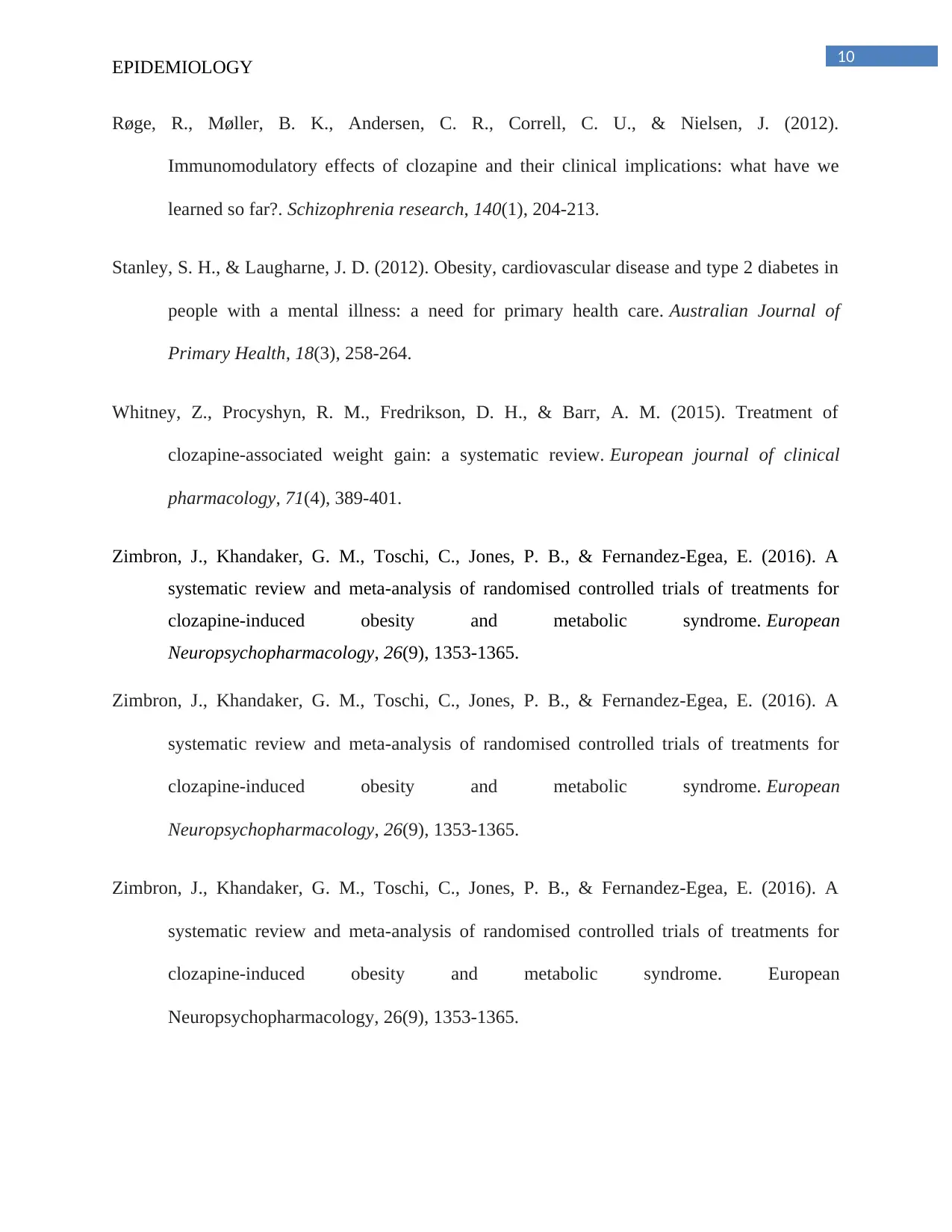
10
EPIDEMIOLOGY
Røge, R., Møller, B. K., Andersen, C. R., Correll, C. U., & Nielsen, J. (2012).
Immunomodulatory effects of clozapine and their clinical implications: what have we
learned so far?. Schizophrenia research, 140(1), 204-213.
Stanley, S. H., & Laugharne, J. D. (2012). Obesity, cardiovascular disease and type 2 diabetes in
people with a mental illness: a need for primary health care. Australian Journal of
Primary Health, 18(3), 258-264.
Whitney, Z., Procyshyn, R. M., Fredrikson, D. H., & Barr, A. M. (2015). Treatment of
clozapine-associated weight gain: a systematic review. European journal of clinical
pharmacology, 71(4), 389-401.
Zimbron, J., Khandaker, G. M., Toschi, C., Jones, P. B., & Fernandez-Egea, E. (2016). A
systematic review and meta-analysis of randomised controlled trials of treatments for
clozapine-induced obesity and metabolic syndrome. European
Neuropsychopharmacology, 26(9), 1353-1365.
Zimbron, J., Khandaker, G. M., Toschi, C., Jones, P. B., & Fernandez-Egea, E. (2016). A
systematic review and meta-analysis of randomised controlled trials of treatments for
clozapine-induced obesity and metabolic syndrome. European
Neuropsychopharmacology, 26(9), 1353-1365.
Zimbron, J., Khandaker, G. M., Toschi, C., Jones, P. B., & Fernandez-Egea, E. (2016). A
systematic review and meta-analysis of randomised controlled trials of treatments for
clozapine-induced obesity and metabolic syndrome. European
Neuropsychopharmacology, 26(9), 1353-1365.
EPIDEMIOLOGY
Røge, R., Møller, B. K., Andersen, C. R., Correll, C. U., & Nielsen, J. (2012).
Immunomodulatory effects of clozapine and their clinical implications: what have we
learned so far?. Schizophrenia research, 140(1), 204-213.
Stanley, S. H., & Laugharne, J. D. (2012). Obesity, cardiovascular disease and type 2 diabetes in
people with a mental illness: a need for primary health care. Australian Journal of
Primary Health, 18(3), 258-264.
Whitney, Z., Procyshyn, R. M., Fredrikson, D. H., & Barr, A. M. (2015). Treatment of
clozapine-associated weight gain: a systematic review. European journal of clinical
pharmacology, 71(4), 389-401.
Zimbron, J., Khandaker, G. M., Toschi, C., Jones, P. B., & Fernandez-Egea, E. (2016). A
systematic review and meta-analysis of randomised controlled trials of treatments for
clozapine-induced obesity and metabolic syndrome. European
Neuropsychopharmacology, 26(9), 1353-1365.
Zimbron, J., Khandaker, G. M., Toschi, C., Jones, P. B., & Fernandez-Egea, E. (2016). A
systematic review and meta-analysis of randomised controlled trials of treatments for
clozapine-induced obesity and metabolic syndrome. European
Neuropsychopharmacology, 26(9), 1353-1365.
Zimbron, J., Khandaker, G. M., Toschi, C., Jones, P. B., & Fernandez-Egea, E. (2016). A
systematic review and meta-analysis of randomised controlled trials of treatments for
clozapine-induced obesity and metabolic syndrome. European
Neuropsychopharmacology, 26(9), 1353-1365.

11
EPIDEMIOLOGY
EPIDEMIOLOGY
⊘ This is a preview!⊘
Do you want full access?
Subscribe today to unlock all pages.

Trusted by 1+ million students worldwide
1 out of 12
Related Documents
Your All-in-One AI-Powered Toolkit for Academic Success.
+13062052269
info@desklib.com
Available 24*7 on WhatsApp / Email
![[object Object]](/_next/static/media/star-bottom.7253800d.svg)
Unlock your academic potential
Copyright © 2020–2025 A2Z Services. All Rights Reserved. Developed and managed by ZUCOL.




